The New Hacker's Dictionary
The New Hacker's Dictionary
Node:Top, Next:Introduction, Previous:(dir), Up:(dir)
#======= THIS IS THE JARGON FILE, VERSION 4.3.3, 20 SEP 2002 =======#
This is the Jargon File, a comprehensive compendium of hacker slang illuminating many aspects of hackish
tradition, folklore, and humor.
This document (the Jargon File) is in the public domain, to be freely used, shared, and modified. There are (by
intention) no legal restraints on what you can do with it, but there are traditions about its proper use to which
many hackers are quite strongly attached. Please extend the courtesy of proper citation when you quote the File,
ideally with a version number, as it will change and grow over time. (Examples of appropriate citation form:
"Jargon File 4.3.3" or "The on-line hacker Jargon File, version 4.3.3, 20 SEP 2002".)
The Jargon File is a common heritage of the hacker culture. Over the years a number of individuals have
volunteered considerable time to maintaining the File and been recognized by the net at large as editors of it.
Editorial responsibilities include: to collate contributions and suggestions from others; to seek out corroborating
information; to cross-reference related entries; to keep the file in a consistent format; and to announce and
distribute updated versions periodically. Current volunteer editors include:
Eric Raymond esr@snark.thyrsus.com
Although there is no requirement that you do so, it is considered good form to check with an editor before
quoting the File in a published work or commercial product. We may have additional information that would be
helpful to you and can assist you in framing your quote to reflect not only the letter of the File but its spirit as
well.
All contributions and suggestions about this file sent to a volunteer editor are gratefully received and will be
regarded, unless otherwise labelled, as freely given donations for possible use as part of this public-domain file.
From time to time a snapshot of this file has been polished, edited, and formatted for commercial publication
with the cooperation of the volunteer editors and the hacker community at large. If you wish to have a bound
paper copy of this file, you may find it convenient to purchase one of these. They often contain additional
material not found in on-line versions. The two `authorized' editions so far are described in the Revision History
section; there may be more in the future.
l Introduction: The purpose and scope of this File
l A Few Terms: Of Slang, Jargon and Techspeak
l Revision History: How the File came to be
http://www.catb.org/~esr/jargon/jargon.html (1 of 780) [4/25/2003 2:57:01 AM]
�
The New Hacker's Dictionary
l Jargon Construction: How hackers invent jargon
l Hacker Writing Style: How they write
l Email Quotes: And the Inclusion Problem
l Hacker Speech Style: How hackers talk
l International Style: Some notes on usage outside the U.S.
l Leet-speak: Crackers, Phreaks, and Lamers
l Pronunciation Guide: How to read the pronunciation keys
l Other Lexicon Conventions: How to read lexicon entries
l Format for New Entries: How to submit new entries for the File
l The Jargon Lexicon: The lexicon itself
l Appendix A: Hacker Folklore
l Appendix B: A Portrait of J. Random Hacker
l Appendix C: Helping Hacker Culture Grow
l Bibliography: For your further enjoyment
Node:Introduction, Next:A Few Terms, Previous:Top, Up:Top
Introduction
This document is a collection of slang terms used by various subcultures of computer hackers. Though some
technical material is included for background and flavor, it is not a technical dictionary; what we describe here
is the language hackers use among themselves for fun, social communication, and technical debate.
The `hacker culture' is actually a loosely networked collection of subcultures that is nevertheless conscious of
some important shared experiences, shared roots, and shared values. It has its own myths, heroes, villains, folk
epics, in-jokes, taboos, and dreams. Because hackers as a group are particularly creative people who define
themselves partly by rejection of `normal' values and working habits, it has unusually rich and conscious
traditions for an intentional culture less than 50 years old.
As usual with slang, the special vocabulary of hackers helps hold their culture together -- it helps hackers
recognize each other's places in the community and expresses shared values and experiences. Also as usual, not
knowing the slang (or using it inappropriately) defines one as an outsider, a mundane, or (worst of all in hackish
vocabulary) possibly even a suit. All human cultures use slang in this threefold way -- as a tool of
communication, and of inclusion, and of exclusion.
Among hackers, though, slang has a subtler aspect, paralleled perhaps in the slang of jazz musicians and some
kinds of fine artists but hard to detect in most technical or scientific cultures; parts of it are code for shared
states of consciousness. There is a whole range of altered states and problem-solving mental stances basic to
http://www.catb.org/~esr/jargon/jargon.html (2 of 780) [4/25/2003 2:57:01 AM]
�
The New Hacker's Dictionary
high-level hacking which don't fit into conventional linguistic reality any better than a Coltrane solo or one of
Maurits Escher's surreal `trompe l'oeil' compositions (Escher is a favorite of hackers), and hacker slang encodes
these subtleties in many unobvious ways. As a simple example, take the distinction between a kluge and an
elegant solution, and the differing connotations attached to each. The distinction is not only of engineering
significance; it reaches right back into the nature of the generative processes in program design and asserts
something important about two different kinds of relationship between the hacker and the hack. Hacker slang is
unusually rich in implications of this kind, of overtones and undertones that illuminate the hackish psyche.
Hackers, as a rule, love wordplay and are very conscious and inventive in their use of language. These traits
seem to be common in young children, but the conformity-enforcing machine we are pleased to call an
educational system bludgeons them out of most of us before adolescence. Thus, linguistic invention in most
subcultures of the modern West is a halting and largely unconscious process. Hackers, by contrast, regard slang
formation and use as a game to be played for conscious pleasure. Their inventions thus display an almost unique
combination of the neotenous enjoyment of language-play with the discrimination of educated and powerful
intelligence. Further, the electronic media which knit them together are fluid, `hot' connections, well adapted to
both the dissemination of new slang and the ruthless culling of weak and superannuated specimens. The results
of this process give us perhaps a uniquely intense and accelerated view of linguistic evolution in action.
Hacker slang also challenges some common linguistic and anthropological assumptions. For example, in the
early 1990s it became fashionable to speak of `low-context' versus `high-context' communication, and to
classify cultures by the preferred context level of their languages and art forms. It is usually claimed that low-
context communication (characterized by precision, clarity, and completeness of self-contained utterances) is
typical in cultures which value logic, objectivity, individualism, and competition; by contrast, high-context
communication (elliptical, emotive, nuance-filled, multi-modal, heavily coded) is associated with cultures
which value subjectivity, consensus, cooperation, and tradition. What then are we to make of hackerdom, which
is themed around extremely low-context interaction with computers and exhibits primarily "low-context"
values, but cultivates an almost absurdly high-context slang style?
The intensity and consciousness of hackish invention make a compilation of hacker slang a particularly
effective window into the surrounding culture -- and, in fact, this one is the latest version of an evolving
compilation called the `Jargon File', maintained by hackers themselves since the early 1970s. This one (like its
ancestors) is primarily a lexicon, but also includes topic entries which collect background or sidelight
information on hacker culture that would be awkward to try to subsume under individual slang definitions.
Though the format is that of a reference volume, it is intended that the material be enjoyable to browse. Even a
complete outsider should find at least a chuckle on nearly every page, and much that is amusingly thought-
provoking. But it is also true that hackers use humorous wordplay to make strong, sometimes combative
statements about what they feel. Some of these entries reflect the views of opposing sides in disputes that have
been genuinely passionate; this is deliberate. We have not tried to moderate or pretty up these disputes; rather
we have attempted to ensure that everyone's sacred cows get gored, impartially. Compromise is not particularly
a hackish virtue, but the honest presentation of divergent viewpoints is.
The reader with minimal computer background who finds some references incomprehensibly technical can
safely ignore them. We have not felt it either necessary or desirable to eliminate all such; they, too, contribute
flavor, and one of this document's major intended audiences -- fledgling hackers already partway inside the
http://www.catb.org/~esr/jargon/jargon.html (3 of 780) [4/25/2003 2:57:01 AM]
�
The New Hacker's Dictionary
culture -- will benefit from them.
A selection of longer items of hacker folklore and humor is included in Appendix A. The `outside' reader's
attention is particularly directed to the Portrait of J. Random Hacker in Appendix B. Appendix C, the
Bibliography, lists some non-technical works which have either influenced or described the hacker culture.
Because hackerdom is an intentional culture (one each individual must choose by action to join), one should not
be surprised that the line between description and influence can become more than a little blurred. Earlier
versions of the Jargon File have played a central role in spreading hacker language and the culture that goes
with it to successively larger populations, and we hope and expect that this one will do likewise.
Node:A Few Terms, Next:Revision History, Previous:Introduction, Up:Top
Of Slang, Jargon, and Techspeak
Linguists usually refer to informal language as `slang' and reserve the term `jargon' for the technical
vocabularies of various occupations. However, the ancestor of this collection was called the `Jargon File', and
hacker slang is traditionally `the jargon'. When talking about the jargon there is therefore no convenient way to
distinguish it from what a linguist would call hackers' jargon -- the formal vocabulary they learn from
textbooks, technical papers, and manuals.
To make a confused situation worse, the line between hacker slang and the vocabulary of technical
programming and computer science is fuzzy, and shifts over time. Further, this vocabulary is shared with a
wider technical culture of programmers, many of whom are not hackers and do not speak or recognize hackish
slang.
Accordingly, this lexicon will try to be as precise as the facts of usage permit about the distinctions among three
categories:
l `slang': informal language from mainstream English or non-technical subcultures (bikers, rock fans,
surfers, etc).
l `jargon': without qualifier, denotes informal `slangy' language peculiar to or predominantly found among
hackers -- the subject of this lexicon.
l `techspeak': the formal technical vocabulary of programming, computer science, electronics, and other
fields connected to hacking.
This terminology will be consistently used throughout the remainder of this lexicon.
The jargon/techspeak distinction is the delicate one. A lot of techspeak originated as jargon, and there is a
steady continuing uptake of jargon into techspeak. On the other hand, a lot of jargon arises from
overgeneralization of techspeak terms (there is more about this in the Jargon Construction section below).
In general, we have considered techspeak any term that communicates primarily by a denotation well
http://www.catb.org/~esr/jargon/jargon.html (4 of 780) [4/25/2003 2:57:01 AM]
�
The New Hacker's Dictionary
established in textbooks, technical dictionaries, or standards documents.
A few obviously techspeak terms (names of operating systems, languages, or documents) are listed when they
are tied to hacker folklore that isn't covered in formal sources, or sometimes to convey critical historical
background necessary to understand other entries to which they are cross-referenced. Some other techspeak
senses of jargon words are listed in order to make the jargon senses clear; where the text does not specify that a
straight technical sense is under discussion, these are marked with `[techspeak]' as an etymology. Some entries
have a primary sense marked this way, with subsequent jargon meanings explained in terms of it.
We have also tried to indicate (where known) the apparent origins of terms. The results are probably the least
reliable information in the lexicon, for several reasons. For one thing, it is well known that many hackish usages
have been independently reinvented multiple times, even among the more obscure and intricate neologisms. It
often seems that the generative processes underlying hackish jargon formation have an internal logic so
powerful as to create substantial parallelism across separate cultures and even in different languages! For
another, the networks tend to propagate innovations so quickly that `first use' is often impossible to pin down.
And, finally, compendia like this one alter what they observe by implicitly stamping cultural approval on terms
and widening their use.
Despite these problems, the organized collection of jargon-related oral history for the new compilations has
enabled us to put to rest quite a number of folk etymologies, place credit where credit is due, and illuminate the
early history of many important hackerisms such as kluge, cruft, and foo. We believe specialist lexicographers
will find many of the historical notes more than casually instructive.
Node:Revision History, Next:Jargon Construction, Previous:A Few Terms, Up:Top
Revision History
The original Jargon File was a collection of hacker jargon from technical cultures including the MIT AI Lab,
the Stanford AI lab (SAIL), and others of the old ARPANET AI/LISP/PDP-10 communities including Bolt,
Beranek and Newman (BBN), Carnegie-Mellon University (CMU), and Worcester Polytechnic Institute (WPI).
The Jargon File (hereafter referred to as `jargon-1' or `the File') was begun by Raphael Finkel at Stanford in
1975. From this time until the plug was finally pulled on the SAIL computer in 1991, the File was named
AIWORD.RF[UP,DOC] there. Some terms in it date back considerably earlier (frob and some senses of moby,
for instance, go back to the Tech Model Railroad Club at MIT and are believed to date at least back to the early
1960s). The revisions of jargon-1 were all unnumbered and may be collectively considered `Version 1'.
In 1976, Mark Crispin, having seen an announcement about the File on the SAIL computer, FTPed a copy of
the File to MIT. He noticed that it was hardly restricted to `AI words' and so stored the file on his directory as
AI:MRC;SAIL JARGON.
The file was quickly renamed JARGON > (the `>' caused versioning under ITS) as a flurry of enhancements
were made by Mark Crispin and Guy L. Steele Jr. Unfortunately, amidst all this activity, nobody thought of
http://www.catb.org/~esr/jargon/jargon.html (5 of 780) [4/25/2003 2:57:01 AM]
�
The New Hacker's Dictionary
correcting the term `jargon' to `slang' until the compendium had already become widely known as the Jargon
File.
Raphael Finkel dropped out of active participation shortly thereafter and Don Woods became the SAIL contact
for the File (which was subsequently kept in duplicate at SAIL and MIT, with periodic resynchronizations).
The File expanded by fits and starts until about 1983; Richard Stallman was prominent among the contributors,
adding many MIT and ITS-related coinages.
In Spring 1981, a hacker named Charles Spurgeon got a large chunk of the File published in Stewart Brand's
"CoEvolution Quarterly" (issue 29, pages 26-35) with illustrations by Phil Wadler and Guy Steele (including a
couple of the Crunchly cartoons). This appears to have been the File's first paper publication.
A late version of jargon-1, expanded with commentary for the mass market, was edited by Guy Steele into a
book published in 1983 as "The Hacker's Dictionary" (Harper & Row CN 1082, ISBN 0-06-091082-8). The
other jargon-1 editors (Raphael Finkel, Don Woods, and Mark Crispin) contributed to this revision, as did
Richard M. Stallman and Geoff Goodfellow. This book (now out of print) is hereafter referred to as `Steele-
1983' and those six as the Steele-1983 coauthors.
Shortly after the publication of Steele-1983, the File effectively stopped growing and changing. Originally, this
was due to a desire to freeze the file temporarily to facilitate the production of Steele-1983, but external
conditions caused the `temporary' freeze to become permanent.
The AI Lab culture had been hit hard in the late 1970s by funding cuts and the resulting administrative decision
to use vendor-supported hardware and software instead of homebrew whenever possible. At MIT, most AI work
had turned to dedicated LISP Machines. At the same time, the commercialization of AI technology lured some
of the AI Lab's best and brightest away to startups along the Route 128 strip in Massachusetts and out West in
Silicon Valley. The startups built LISP machines for MIT; the central MIT-AI computer became a TWENEX
system rather than a host for the AI hackers' beloved ITS.
The Stanford AI Lab had effectively ceased to exist by 1980, although the SAIL computer continued as a
Computer Science Department resource until 1991. Stanford became a major TWENEX site, at one point
operating more than a dozen TOPS-20 systems; but by the mid-1980s most of the interesting software work was
being done on the emerging BSD Unix standard.
In April 1983, the PDP-10-centered cultures that had nourished the File were dealt a death-blow by the
cancellation of the Jupiter project at Digital Equipment Corporation. The File's compilers, already dispersed,
moved on to other things. Steele-1983 was partly a monument to what its authors thought was a dying tradition;
no one involved realized at the time just how wide its influence was to be.
By the mid-1980s the File's content was dated, but the legend that had grown up around it never quite died out.
The book, and softcopies obtained off the ARPANET, circulated even in cultures far removed from MIT and
Stanford; the content exerted a strong and continuing influence on hacker language and humor. Even as the
advent of the microcomputer and other trends fueled a tremendous expansion of hackerdom, the File (and
http://www.catb.org/~esr/jargon/jargon.html (6 of 780) [4/25/2003 2:57:01 AM]
�
The New Hacker's Dictionary
related materials such as the Some AI Koans in Appendix A) came to be seen as a sort of sacred epic, a hacker-
culture Matter of Britain chronicling the heroic exploits of the Knights of the Lab. The pace of change in
hackerdom at large accelerated tremendously -- but the Jargon File, having passed from living document to
icon, remained essentially untouched for seven years.
This revision contains nearly the entire text of a late version of jargon-1 (a few obsolete PDP-10-related entries
were dropped after careful consultation with the editors of Steele-1983). It merges in about 80% of the Steele-
1983 text, omitting some framing material and a very few entries introduced in Steele-1983 that are now also
obsolete.
This new version casts a wider net than the old Jargon File; its aim is to cover not just AI or PDP-10 hacker
culture but all the technical computing cultures wherein the true hacker-nature is manifested. More than half of
the entries now derive from Usenet and represent jargon now current in the C and Unix communities, but
special efforts have been made to collect jargon from other cultures including IBM PC programmers, Amiga
fans, Mac enthusiasts, and even the IBM mainframe world.
Eric S. Raymond maintains the new File with assistance from Guy L. Steele Jr.
; these are the persons primarily reflected in the File's editorial `we', though we take pleasure
in acknowledging the special contribution of the other coauthors of Steele-1983. Please email all additions,
corrections, and correspondence relating to the Jargon File to jargon@thyrsus.com.
(Warning: other email addresses appear in this file but are not guaranteed to be correct later than the revision
date on the first line. Don't email us if an attempt to reach your idol bounces -- we have no magic way of
checking addresses or looking up people.)
The 2.9.6 version became the main text of "The New Hacker's Dictionary", by Eric Raymond (ed.), MIT Press
1991, ISBN 0-262-68069-6.
The 3.0.0 version was published in August 1993 as the second edition of "The New Hacker's Dictionary", again
from MIT Press (ISBN 0-262-18154-1).
The 4.0.0 version was published in September 1996 as the third edition of "The New Hacker's Dictionary" from
MIT Press (ISBN 0-262-68092-0).
If you want the book, you should be able to find it at any of the major bookstore chains. Failing that, you can
order by mail from
The MIT Press 55 Hayward Street Cambridge, MA 02142
or order by phone at (800)-356-0343 or (617)-625-8481.
The maintainers are committed to updating the on-line version of the Jargon File through and beyond paper
publication, and will continue to make it available to archives and public-access sites as a trust of the hacker
community.
http://www.catb.org/~esr/jargon/jargon.html (7 of 780) [4/25/2003 2:57:01 AM]
�
The New Hacker's Dictionary
Here is a chronology of the high points in the recent on-line revisions:
Version 2.1.1, Jun 12 1990: the Jargon File comes alive again after a seven-year hiatus. Reorganization and
massive additions were by Eric S. Raymond, approved by Guy Steele. Many items of UNIX, C, USENET, and
microcomputer-based jargon were added at that time.
Version 2.9.6, Aug 16 1991: corresponds to reproduction copy for book. This version had 18952 lines, 148629
words, 975551 characters, and 1702 entries.
Version 2.9.7, Oct 28 1991: first markup for hypertext browser. This version had 19432 lines, 152132 words,
999595 characters, and 1750 entries.
Version 2.9.8, Jan 01 1992: first public release since the book, including over fifty new entries and numerous
corrections/additions to old ones. Packaged with version 1.1 of vh(1) hypertext reader. This version had 19509
lines, 153108 words, 1006023 characters, and 1760 entries.
Version 2.9.9, Apr 01 1992: folded in XEROX PARC lexicon. This version had 20298 lines, 159651 words,
1048909 characters, and 1821 entries.
Version 2.9.10, Jul 01 1992: lots of new historical material. This version had 21349 lines, 168330 words,
1106991 characters, and 1891 entries.
Version 2.9.11, Jan 01 1993: lots of new historical material. This version had 21725 lines, 171169 words,
1125880 characters, and 1922 entries.
Version 2.9.12, May 10 1993: a few new entries & changes, marginal MUD/IRC slang and some borderline
techspeak removed, all in preparation for 2nd Edition of TNHD. This version had 22238 lines, 175114 words,
1152467 characters, and 1946 entries.
Version 3.0.0, Jul 27 1993: manuscript freeze for 2nd edition of TNHD. This version had 22548 lines, 177520
words, 1169372 characters, and 1961 entries.
Version 3.1.0, Oct 15 1994: interim release to test WWW conversion. This version had 23197 lines, 181001
words, 1193818 characters, and 1990 entries.
Version 3.2.0, Mar 15 1995: Spring 1995 update. This version had 23822 lines, 185961 words, 1226358
characters, and 2031 entries.
Version 3.3.0, Jan 20 1996: Winter 1996 update. This version had 24055 lines, 187957 words, 1239604
characters, and 2045 entries.
Version 3.3.1, Jan 25 1996: Copy-corrected improvement on 3.3.0 shipped to MIT Press as a step towards
TNHD III. This version had 24147 lines, 188728 words, 1244554 characters, and 2050 entries.
http://www.catb.org/~esr/jargon/jargon.html (8 of 780) [4/25/2003 2:57:01 AM]
�
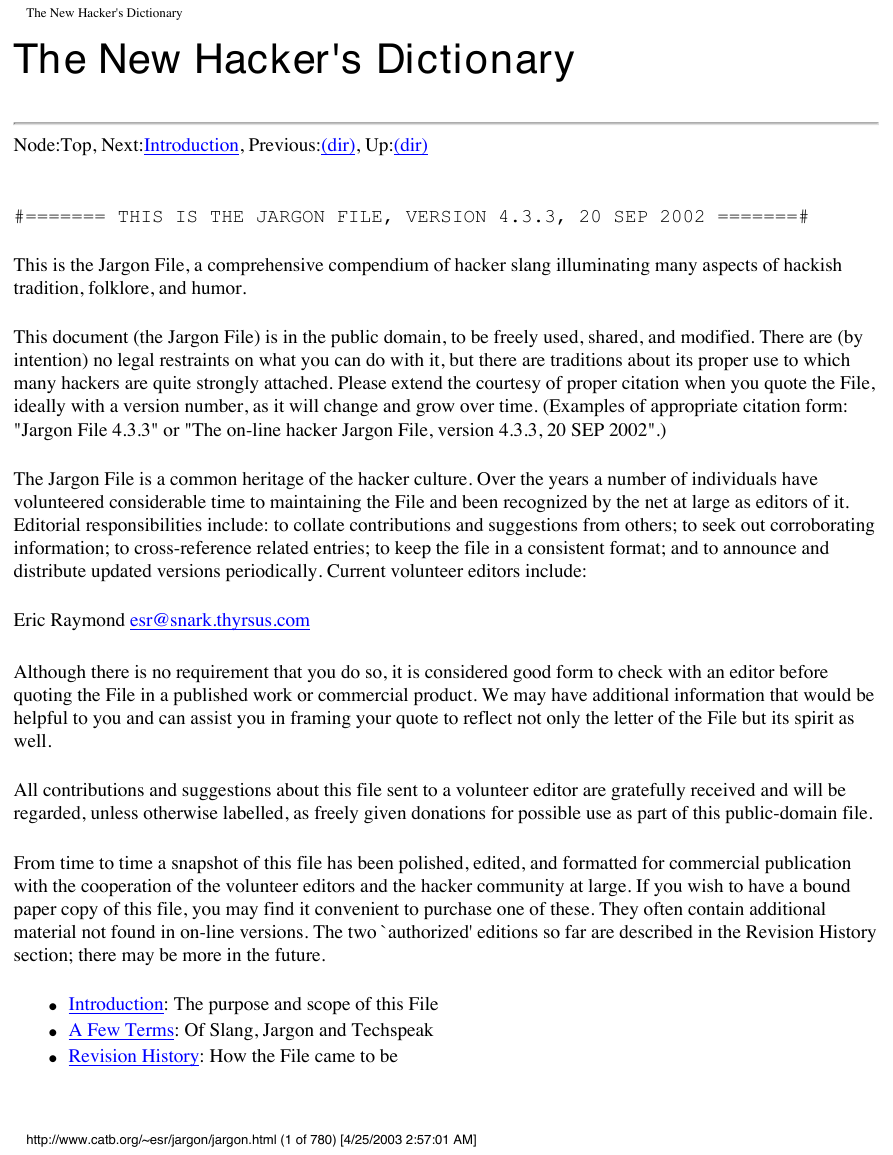

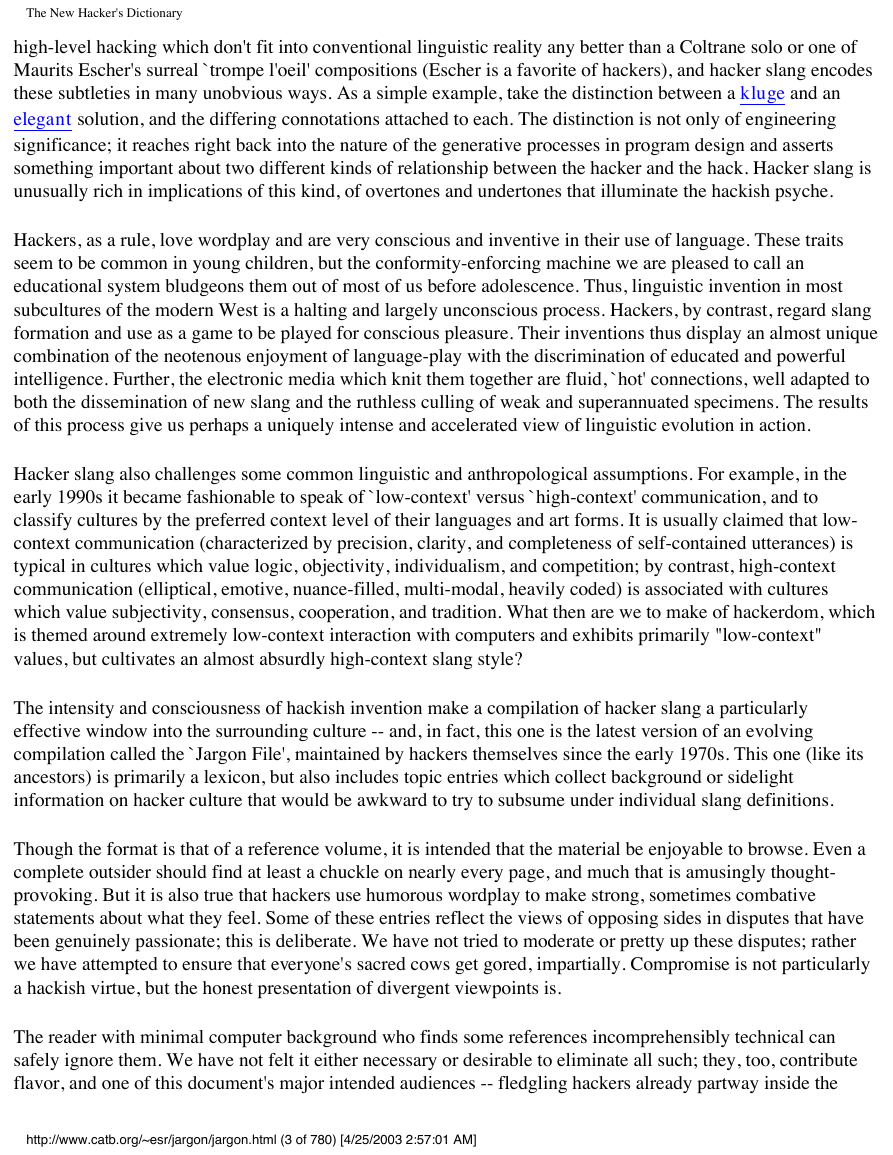
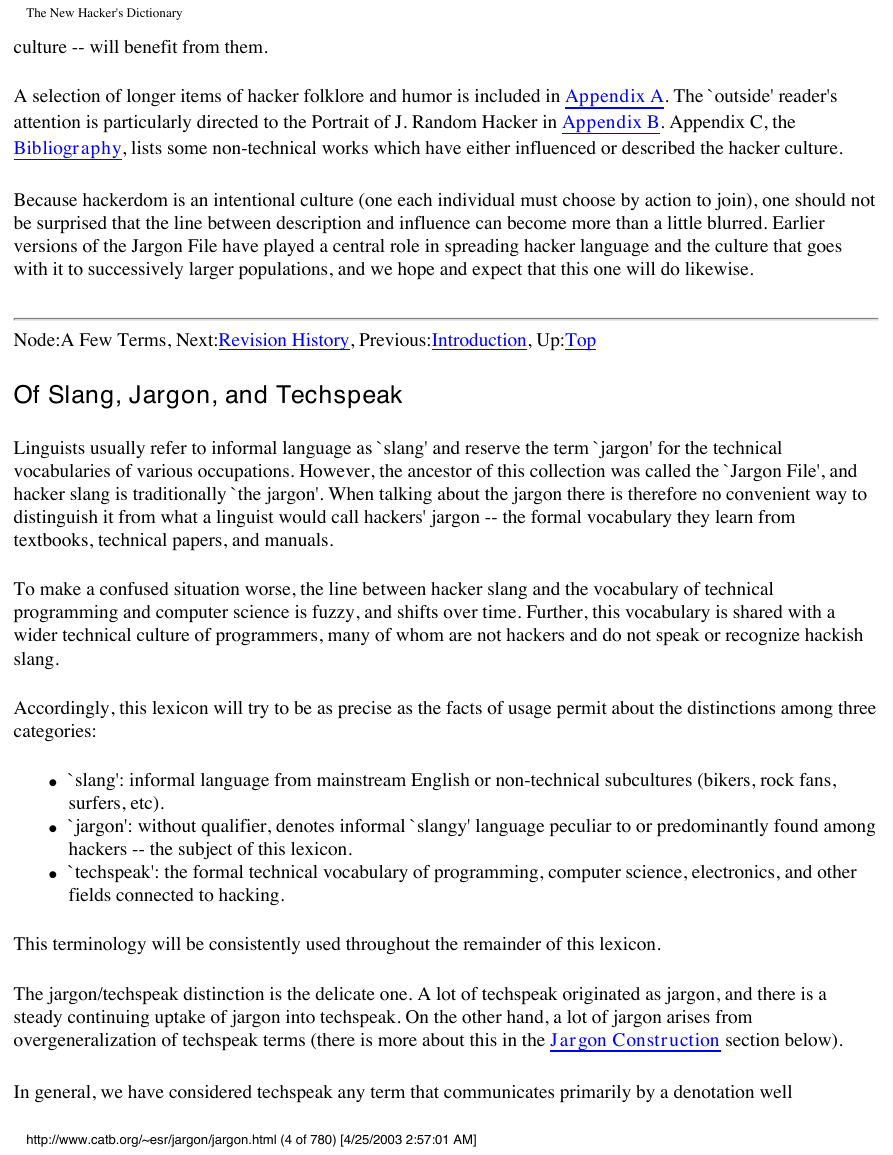

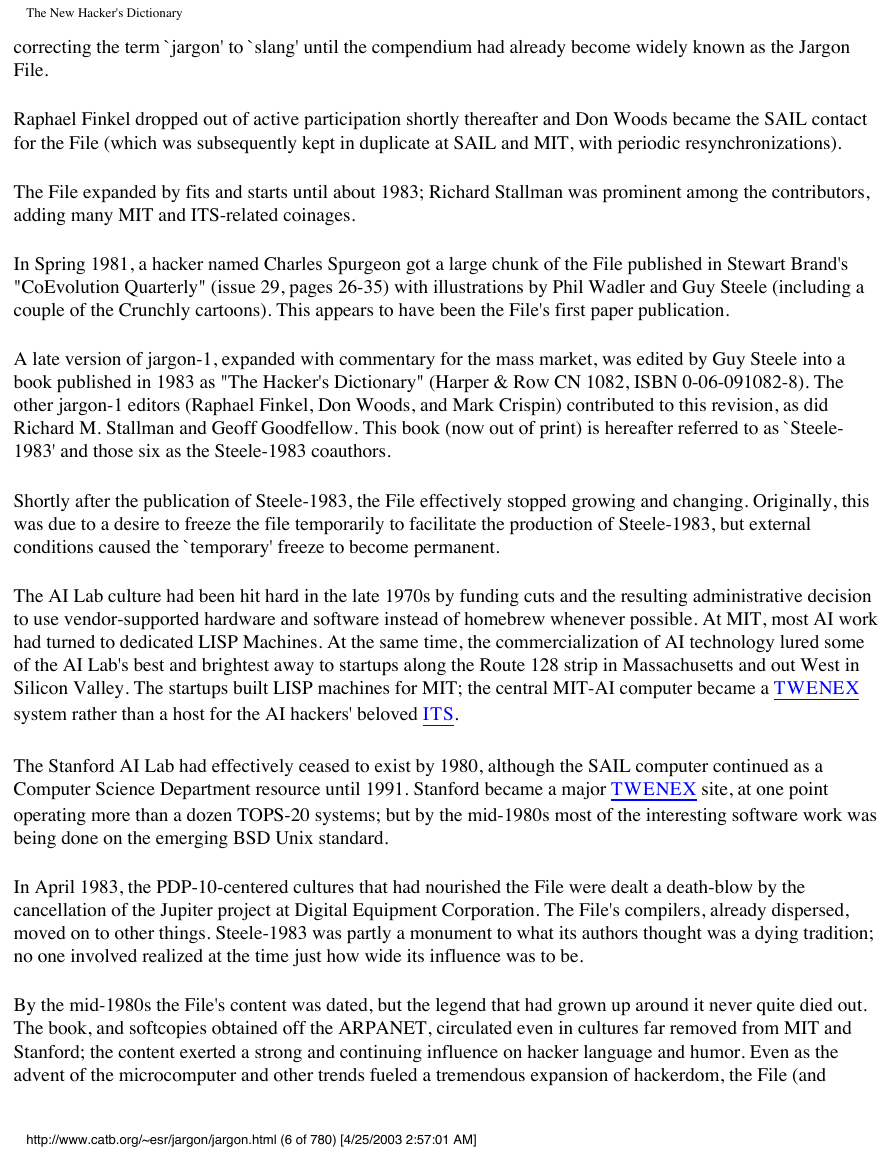

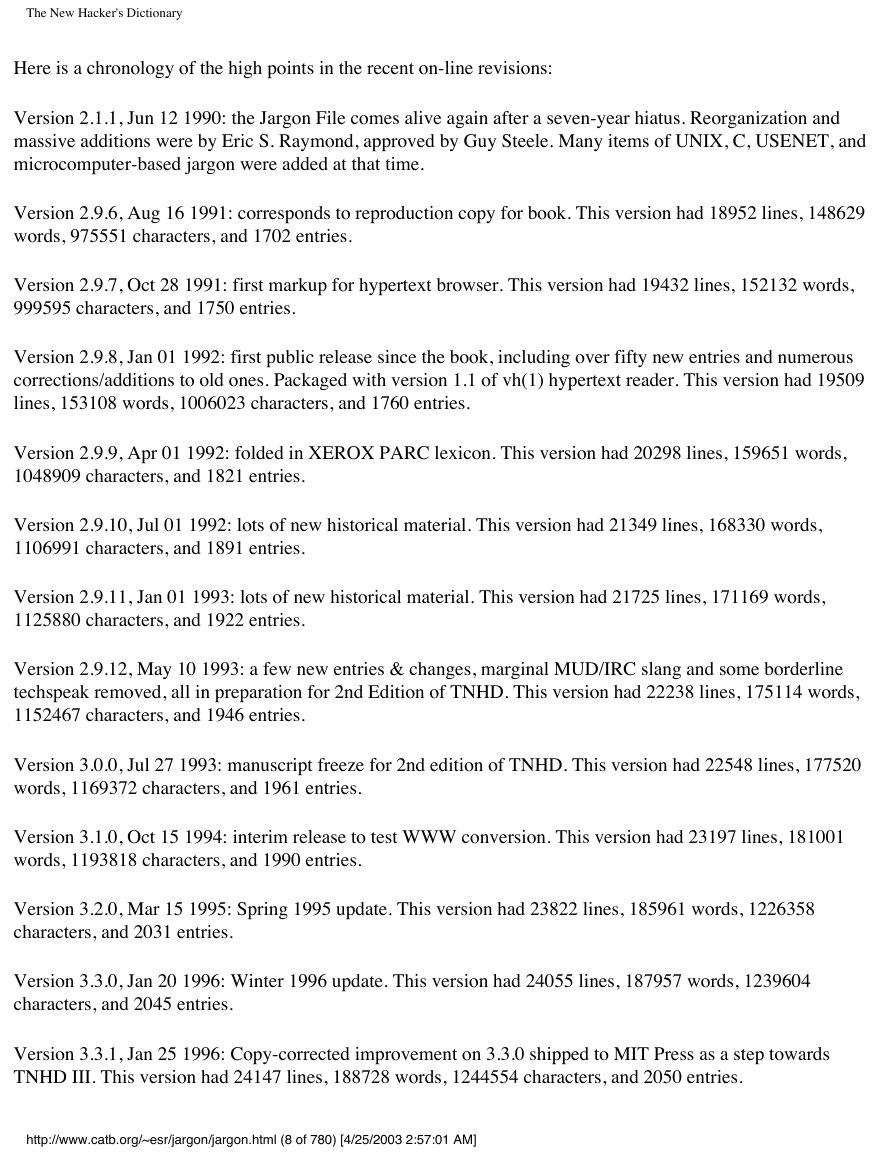








 2023年江西萍乡中考道德与法治真题及答案.doc
2023年江西萍乡中考道德与法治真题及答案.doc 2012年重庆南川中考生物真题及答案.doc
2012年重庆南川中考生物真题及答案.doc 2013年江西师范大学地理学综合及文艺理论基础考研真题.doc
2013年江西师范大学地理学综合及文艺理论基础考研真题.doc 2020年四川甘孜小升初语文真题及答案I卷.doc
2020年四川甘孜小升初语文真题及答案I卷.doc 2020年注册岩土工程师专业基础考试真题及答案.doc
2020年注册岩土工程师专业基础考试真题及答案.doc 2023-2024学年福建省厦门市九年级上学期数学月考试题及答案.doc
2023-2024学年福建省厦门市九年级上学期数学月考试题及答案.doc 2021-2022学年辽宁省沈阳市大东区九年级上学期语文期末试题及答案.doc
2021-2022学年辽宁省沈阳市大东区九年级上学期语文期末试题及答案.doc 2022-2023学年北京东城区初三第一学期物理期末试卷及答案.doc
2022-2023学年北京东城区初三第一学期物理期末试卷及答案.doc 2018上半年江西教师资格初中地理学科知识与教学能力真题及答案.doc
2018上半年江西教师资格初中地理学科知识与教学能力真题及答案.doc 2012年河北国家公务员申论考试真题及答案-省级.doc
2012年河北国家公务员申论考试真题及答案-省级.doc 2020-2021学年江苏省扬州市江都区邵樊片九年级上学期数学第一次质量检测试题及答案.doc
2020-2021学年江苏省扬州市江都区邵樊片九年级上学期数学第一次质量检测试题及答案.doc 2022下半年黑龙江教师资格证中学综合素质真题及答案.doc
2022下半年黑龙江教师资格证中学综合素质真题及答案.doc